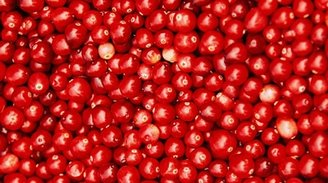撰文\播音:克里斯托弗·因塔利亚塔(Christopher Intagliata)
翻译:Ada
校对:许楠
Wisconsin is famous for cheese. But it's also the United States' number-one producer of a tart, red fruit that’s on pretty much every Thanksgiving dinner table.
威斯康辛州的奶酪非常出名。同时还有一种酸酸的红色水果的产量也是全美第一,几乎占领了感恩节时家家户户的餐桌。
"We have this reputation of being the dairy state, but cranberries outnumber the cows." Susan Hagness, an electrical engineer at the University of Wisconsin—Madison.
威斯康辛大学麦迪逊分校的电子工程师Susan Hagness说道:“我们享有乳业基地的盛誉,但我们蔓越莓的产量实际上超过了奶牛的数量。”
Cranberries, she says, are big business—they’re the official state fruit! And supply chain managers need estimates of the size of the upcoming harvest. Which can be hard to make.
她还说:蔓越莓生产是一笔大生意——因为这是该州的官方代表水果!而供应商需要估算接下来收成的情况,但就现在来说,还是十分困难的。
"The current approach for estimating cranberry yield is literally to go out into the field and hand pick and hand count all the cranberries in a one-square-foot area. This is obviously an inefficient and laborious approach. There can be up to 900 berries per square foot."
“现在估算蔓越莓产量的方法还是直接走进田间进行采摘,并人工计算一平方英尺内蔓越莓的数量。这个方法毫无疑问是非常低效且费力的,因为每平方英尺蔓越莓的数量可能会超过900个!”
So scientists from Ocean Spray asked Hagness for help. And she and her team found in lab tests that zapping cranberry plants with microwaves, and then studying the signal that bounces back, might work. Recall that your microwave oven works by exciting water molecules in whatever you’re heating up. Same concept here: microwaves interact differently with plump, juicy cranberries—which contain lots of water—than they do with leaves. The return signal thus provides a good estimate of the number of cranberry clusters in a given plot.
所以,优鲜沛(Ocean Spray)相关研发的科学家想要寻求Hagness的帮助。她和她的团队在实验室中用微波扫描蔓越莓植株,然后研究反射回来的信号。他们发现这个方法或许有效:回忆一下家里的微波炉,无论你放进去什么,都通过激发其内部的水分子加大震动频率来达到加热的目的。在这里是同样的概念:饱满多汁的蔓越莓含有更有的水,所以微波对它们的作用与叶子不同。返回的信号经过合适的算法处理,可以对蔓越莓数量做出一个很好估计。
By the way, the microwaves for this application are very low power—on par with the radiation that comes out of a cell phone. "You know we're not cooking the cranberries right there in the field."
顺便一提,这个应用中使用的微波能量很低——与手机发出的辐射差不多。“要知道,我们并不想把田里的蔓越莓煮熟。”
The team presented their preliminary results at an IEEE conference earlier this year. [A Haufler et al., Feasibility of Efficient and Accurate Estimation of Cranberry Crop Yield using Microwave Sensing]
今年早些时候,团队他们的初步成果发表在了IEEE会议上。
Since then they’ve moved from the lab to the bog—they’re currently analyzing data from tests done during this year's crop. If the method holds up, it might give cranberry growers something to be thankful for.
之后,他们就从实验室里搬到了野外——现在他们已经在实际中做测试,来估计今年的收成。如果这个方案能够成功,它将给予蔓越莓生产商梦寐以求的东西。

 京公网安备11010502039775号
京公网安备11010502039775号  京公网安备11010502039775号
京公网安备11010502039775号 
















